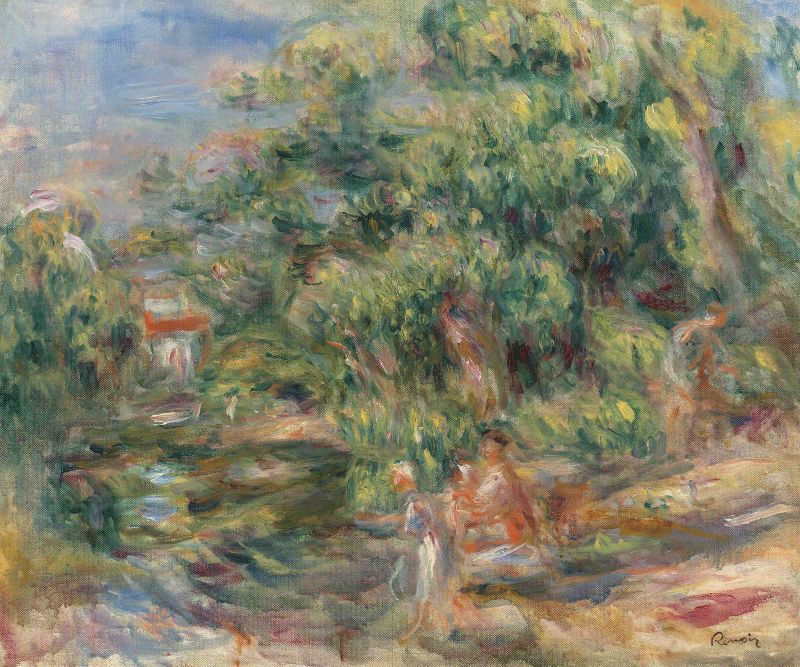Pierre-Auguste Renoir
(French, 1841-1919)
Lavandières au bord du Loup
1917
oil on canvas
47 x 55.6 cm (18½ x 21⅞ in.)
stamped 'Renoir' (lower right)
Bernheim-Jeune, Paris (acquired from Succession Pierre-Auguste Renoir, Cagnes, after 1919)
Sale: Christie's London, 28 November 1972, lot 26 (titled Bords du Loup)
Raymond J. Wilson (acquired at the above sale)
M. Knoedler & Co., New York
Sale: Sotheby's New York, 18 May 1983, lot 28
Sale: Sotheby's New York, 12 November 1987, lot 320
Private collection (acquired c.1989-90)
Sale: Christie’s London, 28 February 2019, lot 426
Private collection, London (acquired at the above sale)
Private collection, Europe (acquired from the above in 2019
M. A. Andre & M. Edler, L'Atelier de Renoir, vol. I, Paris, 1931, no. 493, pl. 156 (titled Bords du Loup, illustrated)
G. P. & M. Dauberville, Renoir: Catalogue raisonné des tableaux, pastels, dessins et aquarelles, vol. v, Paris, 2014, no. 3917, p. 169 (titled Bords du Loup, illustrated)
This work will be included in the forthcoming Pierre-Auguste Renoir Digital Catalogue Raisonné, currently being prepared under the sponsorship of the Wildenstein Plattner Institute, Inc.
Glowing with the warm colours of the Mediterranean coast, 'Lavandières au bord du Loup' belongs to a series of extemporaneous, radical landscapes which Pierre-Auguste Renoir executed at the glorious end of his career. Captured with loose and unfettered brushstrokes, the picture portrays an idyllic scene, as a group of figures appear to clean laundry by a river in the middle of wild and luxuriant vegetation. Renoir's bold juxtapositions of colours successfully capture the vibrant visual richness of Southern France’s countryside, testifying to the ability of the painter’s eye to transpose on the canvas the ever-changing appearance of nature through light and swift brushstrokes.
As Gilles Bourdos memorably evoked in his critically acclaimed 2012 film 'Renoir', the master of Cagnes-sur-Mer lived during his final years in a world of women. Nearly all the local men, those who were not too young, old, or infirm, including Renoir’s two sons Pierre and Jean, had taken up arms for their country during the First World War. During the high summer of 1917, when Renoir painted this 'Lavandières au bord du Loup', the November armistice which ended the war was still more than a year away. The artist’s youngest son Claude (“Coco”) had just turned sixteen and was still at his side. Since the death of his wife Aline in 1915, aged only 56, the women in Renoir’s life were now his nurse Louise, his cook Marie Dupuis (“La Boulangère”), the housekeeper Nénette, and, of course, the beautiful teenaged girls who posed for him, now chiefly Andrée (“Dédée”) Heuschling–whom Jean married in 1920–and Madeleine Bruno. Two of these models or members of the household are likely those present in this painting, with a related child or two. The figures fuse with the flame-like chroma of their surroundings forming a timelessly serene realm of dazzling light, palpable warmth and sensual abundance.
Renoir and Monet were the great surviving charter members of the Impressionist circle. Unlike Monet and Degas in their old age, Renoir’s eyesight was a keen as ever. Although he suffered from painful rheumatoid arthritis, which confined him to a wheelchair, Renoir painted every day except Sunday. Matisse, a visitor to Les Collettes during late 1917 and early 1918, was astonished to see him creating “all his best work!” as he later declared. “The soul in him seemed to grow continually stronger and express itself with radiant ease” (quoted in F. Harris, Contemporary Portraits, Fourth Series, New York, 1923, p. 125). The artist painted 'Lavandières au bord du Loup' as part of a series of such plein air scenes as he began work on the final masterwork of his career, 'Les baigneuses', 1918-19 (Musée d’Orsay, Paris).
“Renoir’s life was a display of fireworks to the end,” Jean Renoir wrote. “Although his palette became more and more austere, the most dazzling colours, the most daring contrasts issued from it. It was as if all Renoir’s love of the beauty of this life, which he could no longer enjoy physically, had gushed out of his whole tortured being. He was radiant...by which I mean we felt there were rays emanating from his brush, as it caressed the canvas... So he strode with giant steps toward that summit where mind and matter become one, knowing full well that no man can attain these heights. Each stroke of his brush...declared to the men of this century, already deep in their task of destruction, the stability of the eternal balance of nature” (Renoir, My Father, New York, 1958, p. 421).
Price:
POA
More artworks by Pierre-Auguste Renoir ▶
You may also like:
Enquire Now
Fill in the form below and we will respond as soon as possible.
Make an offer
Fill in the form below and we will respond as soon as possible.

